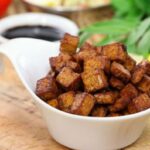Levantine cuisine has long since become an absolute culinary trend here too. One country, in particular, is way ahead when it comes to healthy and tasty cuisine from the eastern Mediterranean region.
What is Levantine cuisine?
Colorful, spicy, healthy, rich in vitamins – and a delight for both the palate and the eyes: this is the Levante cuisine, which has long been celebrated in Central Europe and around the world. The word “Levante” refers to the region around the eastern Mediterranean.
These include Israel, Jordan, Syria, Palestine, and Lebanon, among others. This region used to be called the Orient, but today the term is considered obsolete and is no longer used.
This is what Levant cuisine stands for
When you think of Levantine cuisine, you think of lots of spices and flavors, tasty and light dishes that are usually pretty healthy too. With this food culture, not only does the food itself look spectacular but also the table setting.
Here it is by no means about serving dish after dish individually – everything is served at the same time and served in small bowls. One speaks here of so-called mezze dishes. These are comparable to tapas: the term does not refer to what but how it is served – i.e. in small portions and in large selection and variety.
It’s about sharing
Eating is not only a culinary experience but also a social event – because the mentality of sharing and connecting when eating is an essential part of Levantine cuisine.
Mezze dishes are about sharing, they are placed in the middle of the table and everyone should be able to access them.
Israel as a key factor
The fact that the Levantine cuisine really took off in terms of popularity and spread is largely thanks to Israel. Like no other country, Israel – and above all Tel Aviv – combines the cuisine of numerous cultures.
Israel does not celebrate this multiculturalism in the kitchen as an exception, but as a central aspect of the domestic kitchen. The influences range from the Arabic region to colonial influences – you can find culinary traces from Persia as well as from France or Great Britain.
The reason for the great popularity in Europe
This means that Levantine cuisine fits in perfectly with the current zeitgeist for a number of reasons. Firstly, because not only international, but also fusion cuisine is combined. Secondly – and this is at least as fundamental a reason – the meatless diet is becoming more and more popular.
Meat is more the exception than the rule here: most of the dishes are vegetarian, and many are also suitable for vegans. The majority of the dishes are based on fresh vegetables – making the Levante diet not only healthy but also an option for those wanting to lose weight.
Popular dishes of the Levantine cuisine
The most well-known dishes, which you can easily find almost everywhere in Germany, are hummus and falafel (fried balls made from chickpeas). Also popular is tabbouleh, a salad made from bulgur or couscous and prepared with lemon juice, peppermint, tomatoes, parsley, spring onion, and olive oil.
Aubergine and cauliflower are often used in Levantine cuisine. For example, the puree Baba Ghanoush is made from aubergines – delicious with flatbread, for example. Another specialty in Israeli cuisine is shakshuka – poached eggs are prepared here in a tomato-chili-onion sauce.
The spices
The be-all and end-all are the spices. They play a large part in making the Levante cuisine taste so spectacular and varied. She does not rely on pepper and salt but seduces with a number of spices that Central European palates are perhaps not quite so familiar with.
This includes, among other things, sumac, which is made from the dried and crushed fruits of the sumac bush. In terms of its function, sumac is comparable to salt and pepper – in Levantine cuisine, it is often used to season and fine-tune the taste.
Za’atar and Harissa are two spice mixes that are also found over and over again. Harissa comes from North Africa and consists of chili flakes, coriander, garlic, paprika powder, and cumin.
Za’atar is also used in North Africa, but also in Turkey and the Middle East – often as a spice for dips or spreads. The mixture consists of sesame seeds, sour sumac, marjoram, thyme, oregano, and cumin – we definitely recommend trying it!



